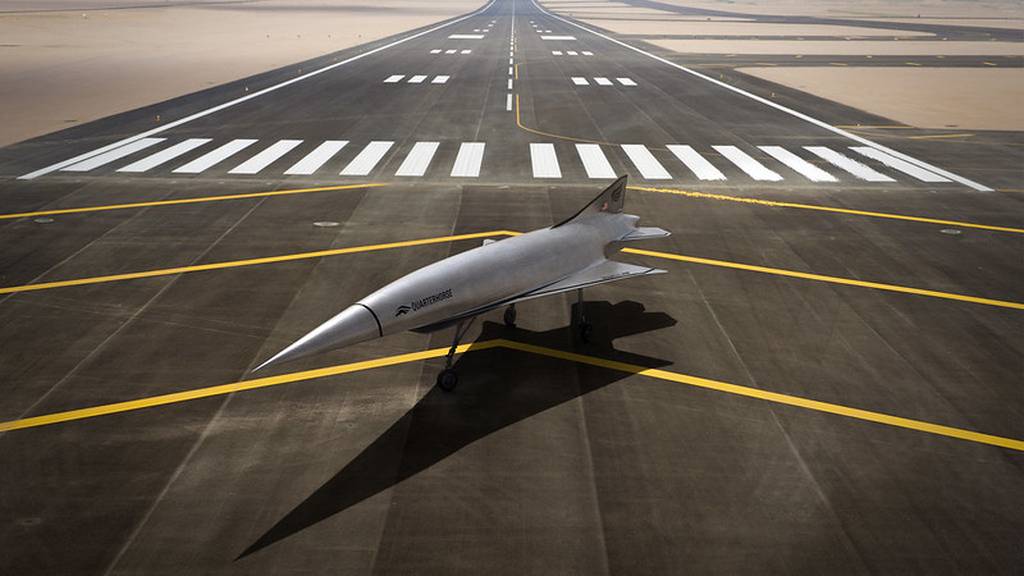
Editor’s note: This story has been updated with information from the Defense Innovation Unit.
WASHINGTON — Hypersonic technology company Hermeus is partnering with the Defense Innovation Unit to demonstrate high-speed capabilities through its commercial prototype aircraft, Quarterhorse.
The Atlanta-based company announced the multiyear contract Nov. 13. While a spokesperson declined to disclose the length of the deal, the company told C4ISRNET it received a $23 million contract for the first year of work.
“The multiyear award will feature Hermeus’ iterative approach to technology maturation and aircraft development,” the company said in a statement. “Through this contract, Hermeus will demonstrate key enabling technologies for hypersonic aircraft in relevant environments preparing them for introduction into future programs.”
Those technologies include propulsion systems, thermal management, power generation and mission system capabilities.
The contract is part of the DIU’s Hypersonic and High-Cadence Airborne Testing Capabilities program, or HyCAT, which is leveraging commercial technology to increase the Defense Department’s hypersonic flight-testing capacity.
The Pentagon has at least 70 programs across the military services that aim to develop hypersonic weapons and aircraft, which can travel at speeds of Mach 5 or higher. However, the infrastructure needed to support testing for those programs, including flying testbeds, is in high demand. That shortfall limits how often the department can conduct flight tests to validate a system’s full performance or to test supporting technology.
DIU previously awarded HyCAT contracts to Hypersonix, an Australian company, and California-based firms Rocket Lab and Fenix space. The agency expects Hypersonix’ DART AE test platform to fly as early as next summer, with Rocket Lab’s HASTE vehicle providing suborbital launch support.
GE Aerospace will also prototype an affordable air-launched, air-breathing testbed.
“This suite of current and future commercial capabilities provide the DoD cost-effective, high-cadence test options using the best of today’s recoverable technologies and tomorrow’s reusable technologies,” Barry Kirkendell, technical director of DIU’s space portfolio, said in a Nov. 13 statement.
Hermeus expects Quarterhorse to log its first flight in 2024. The testbed will carry the company’s Chimera turbine-based combined cycle engine, which is built on General Electric’s J85 turbojet system.
The access to flight testing and technology validation opportunities through partnerships with DIU and other defense agencies will not only allow the company plans to mature Quarterhorse and Chimera, but will also contribute to its work on a second vehicle called Dark Horse.
“We’re excited to transition Quarterhorse to deliver high-speed flight test as a service and leverage it to mature the key technologies for Darkhorse,” Hermeus CEO AJ Piplica said in a statement. “This contract is a key element of our strategy to bridge the valley of death on the way to a future operational hypersonic aircraft program.”
DIU is also pursuing a second phase to the program, dubbed HyCAT 2, focused on working with companies to provide payloads and other technology to integrate onto the test vehicles. That includes alternative navigation and advanced communication payloads, manufacturing technology and low-cost materials.
The organization has partnered with California-based NXTRAC to provide guidance, navigation and control solutions through HyCAT 2.
Courtney Albon is C4ISRNET’s space and emerging technology reporter. She has covered the U.S. military since 2012, with a focus on the Air Force and Space Force. She has reported on some of the Defense Department’s most significant acquisition, budget and policy challenges.
- SEO Powered Content & PR Distribution. Get Amplified Today.
- PlatoData.Network Vertical Generative Ai. Empower Yourself. Access Here.
- PlatoAiStream. Web3 Intelligence. Knowledge Amplified. Access Here.
- PlatoESG. Carbon, CleanTech, Energy, Environment, Solar, Waste Management. Access Here.
- PlatoHealth. Biotech and Clinical Trials Intelligence. Access Here.
- Source: https://www.defensenews.com/battlefield-tech/hypersonics/2023/11/13/hermeus-quarterhorse-to-test-hypersonics-for-defense-innovation-unit/



